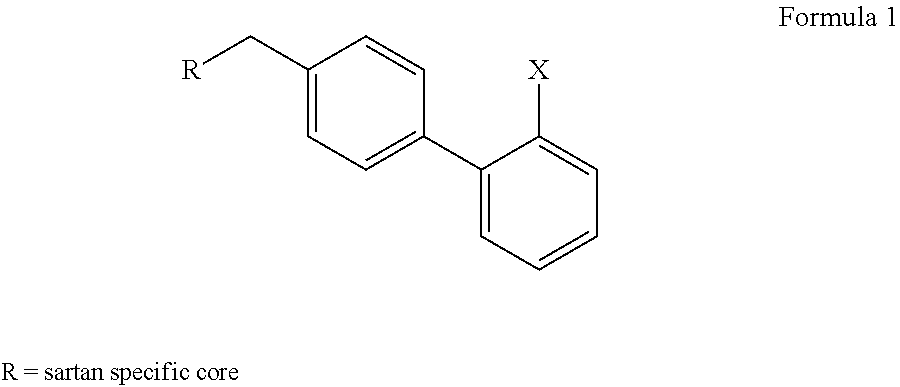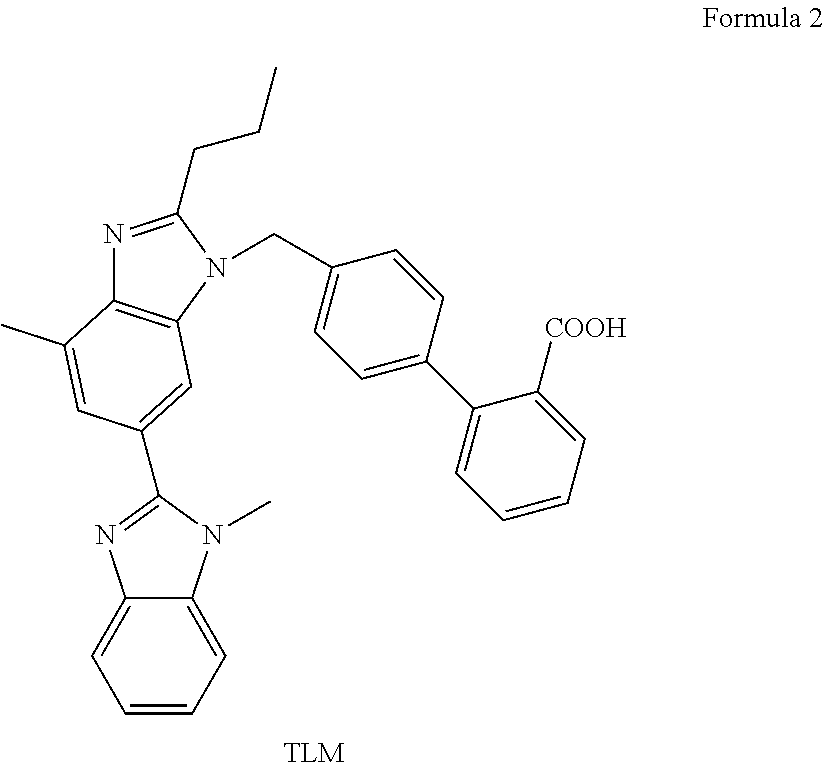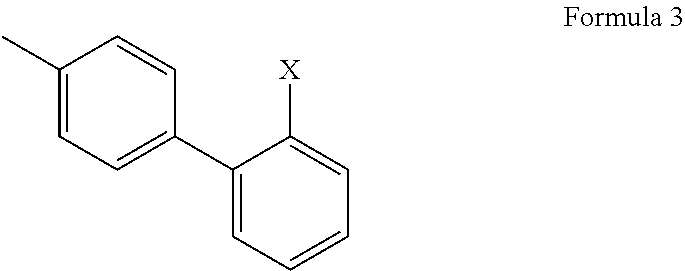2'-halobiphenyl-4-yl intermediates in the synthesis of angiotensin ii antagonists
a technology of angiotensin ii and intermediates, applied in the field of organic chemistry, can solve the problems of not finding an application in the industry and not being economically favorable for industrial application
- Summary
- Abstract
- Description
- Claims
- Application Information
AI Technical Summary
Problems solved by technology
Method used
Image
Examples
example 1
[0043]
[0044]Formation of Grignard Reagent
[0045]60 mL of tetrahydrofuran is charged to the flask. 9 g (52.6 mmol) of p-bromotoluene is added and the solution is maintained at 20° C. 3.0 g (125 mmol) of Mg is added and stirred for minimal 30 minutes.
[0046]Coupling
[0047]9.3 g (48.7 mmol) of 1-bromo-2-chlorobenzene in 5 mL of THF is added into the prepared reaction mixture of p-toluyl magnesium bromide and remaining magnesium at 55° C. in 2 hours and stirred at 55° C. for 2 hours.
[0048]Quenching
[0049]The prepared solution of 2-magnesium bromide-4′-methyl-biphenyl is cooled to room temperature, and 20 mL of tetrahydrofuran with further 12.3 g (48.7 mmol) of iodine (I2) are added. The mixture is agitated for minimum 5 minutes. The remaining iodine in neutralised with aqueous solution of NaHSO3. 70 mL of demineralised water and 50 mL of n-hexane are added. The phases are separated and the upper (n-hexane) phase is evaporated. The 15.6 g of yellowish liquid is obtained.
[0050]The product is ...
example 2
Bromination of 2-iodo-4′-methyl-biphenyl
[0052]
[0053]20 mL of dichloromethane (DCM) is charged to the flask. 0.73 g of N-bromosuccinimide (NBS), 0.08 g of 2,2′-azoisobutyronitrile (AIBN), 18 pL of Br2 and 0.9 g of 2-iodo-4′-methyl-biphenyl are added. The reaction is carried out under reflux temperature for minimum 2 hours and the flask is lighted all the time. The reaction is quenched with aqueous solution of Na2S2O3. The phases are separated and the lower DCM phase is washed with demineralised water one more time. The DCM phase is evaporated and 4 mL of n-hexane is charged and stirred at room temperature for 30 minutes. The suspension is then cooled to 0° C. and filtered. The cake is washed with 2 mL of solvent. 0.6 g of white crystals of 4′-bromomethyl-2-iodo-biphenyl is obtained.
[0054]1H NMR (300 MHz, CDCl3) δ: 4.58 (s, 2H), 7.06 (dt, J=7.6 Hz, J=1.8 Hz, 1H), 7.31 (dd, J=7.7 Hz, J=1.8 Hz, 1H), 7.35 (d, J=8.2 Hz, 2H), 7.40 (dt, J=7.4 Hz, J=1.2 Hz, 1H), 7.48 (d, J=8.2 Hz, 2H), 7.98 ...
example 3
Bromination of 2-iodo-4′-methyl-biphenyl
[0055]15.9 g of 2-iodo-4′-methyl-biphenyl is dissolved in 140 mL of dichloromethane (DCM) than 0.7 g of 2,2′-azoisobutyronitrile (AIBN), and slowly first 1,83 mL and after 1 h additional 1.14 ml of Br2 are added. The reaction is carried out under reflux temperature for 5 hours and the flask is lighted all the time. The reaction is quenched with aqueous solution of Na2S2O3. The phases are separated and the lower DCM phase is washed with demineralised water one more time. The DCM phase is evaporated and 40 mL of n-hexane is charged and stirred at 40° C. for 30 minutes. The suspension is then cooled to 0° C. and filtered. The cake is washed with 15 mL of hexane and 11,0 g of white crystals of 4′-bromomethyl-2-iodo-biphenyl is obtained.
[0056]1H NMR (300 MHz, CDCl3) δ: 4.58 (s, 2H), 7.06 (dt, J=7.6 Hz, J=1.8 Hz, 1H), 7.31 (dd, J=7.7 Hz, J=1.8 Hz, 1H), 7.35 (d, J=8.2 Hz, 2H), 7.40 (dt, J=7.4 Hz, J=1.2 Hz, 1H), 7.48 (d, J=8.2 Hz, 2H), 7.98 (dd, J=7.9...
PUM
| Property | Measurement | Unit |
|---|---|---|
| temperature | aaaaa | aaaaa |
| temperature | aaaaa | aaaaa |
| temperature | aaaaa | aaaaa |
Abstract
Description
Claims
Application Information
 Login to View More
Login to View More - R&D
- Intellectual Property
- Life Sciences
- Materials
- Tech Scout
- Unparalleled Data Quality
- Higher Quality Content
- 60% Fewer Hallucinations
Browse by: Latest US Patents, China's latest patents, Technical Efficacy Thesaurus, Application Domain, Technology Topic, Popular Technical Reports.
© 2025 PatSnap. All rights reserved.Legal|Privacy policy|Modern Slavery Act Transparency Statement|Sitemap|About US| Contact US: help@patsnap.com



